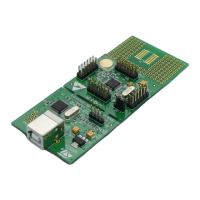Universal asynchronous receiver transmitter (UART) RM0016
344/449 Doc ID 14587 Rev 8
UART clock tolerance when unsynchronized
When LIN slaves are unsynchronized (meaning no characters have been transmitted for a
relatively long time), the maximum tolerated deviation of the UART clock is +/-14%.
If the deviation is within this range then the LIN Break is detected properly when a new
reception occurs.
This is made possible by the fact that masters send 13 low bits for the LIN Break, which can
be interpreted as 11 low bits (13 bits -14% = 11.18) by a "fast" slave and then considered as
a LIN Break. According to the LIN specification, a LIN Break is valid when its duration is
greater than t
SBRKTS
= 10. This means that the LIN Break must last at least 11 low bits.
If the period desynchronization of the slave is +14% (slave too slow), the character "00h"
which represents a sequence of 9 low bits must not be interpreted as a break character (9
bits + 14% = 10.26). Consequently, a valid LIN break must last at least 11 low bits.
Clock deviation causes
The causes which contribute to the total deviation are:
● DTRA: Deviation due to transmitter error. Note: the transmitter can be either a master
or a slave (in case of a slave listening to the response of another slave).
● DMEAS: Error due to the LIN Synch measurement performed by the receiver.
● DQUANT: Error due to the baud rate quantization of the receiver.
● DREC: Deviation of the local oscillator of the receiver: This deviation can occur during
the reception of one complete LIN message assuming that the deviation has been
compensated at the beginning of the message.
● DTCL: Deviation due to the transmission line (generally due to the transceivers)
● All the deviations of the system should be added and compared to the UART clock
tolerance:
– DTRA + DMEAS+ DQUANT + DREC + DTCL < 3.75%
Error due to LIN synch measurement
The LIN Synch Field is measured over eight bit times.
This measurement is performed using a counter clocked by the CPU clock. The edge
detections are performed using the CPU clock cycle.
This leads to a precision of 2 CPU clock cycles for the measurement which lasts
8*UARTDIV clock cycles.
Consequently, this error (DMEAS) is equal to:
2 / (8*UARTDIVMIN)
UARTDIVMIN corresponds to the minimum LIN prescaler content, leading to the maximum
baud rate, taking into account the maximum deviation of +/-14%.
Error due to baud rate quantization
The baud rate can be adjusted in steps of 1 / (UARTDIV). The worst case occurs when the
"real" baud rate is in the middle of the step.
This leads to a quantization error (DQUANT) equal to 1 / (2*UARTDIVMIN).

